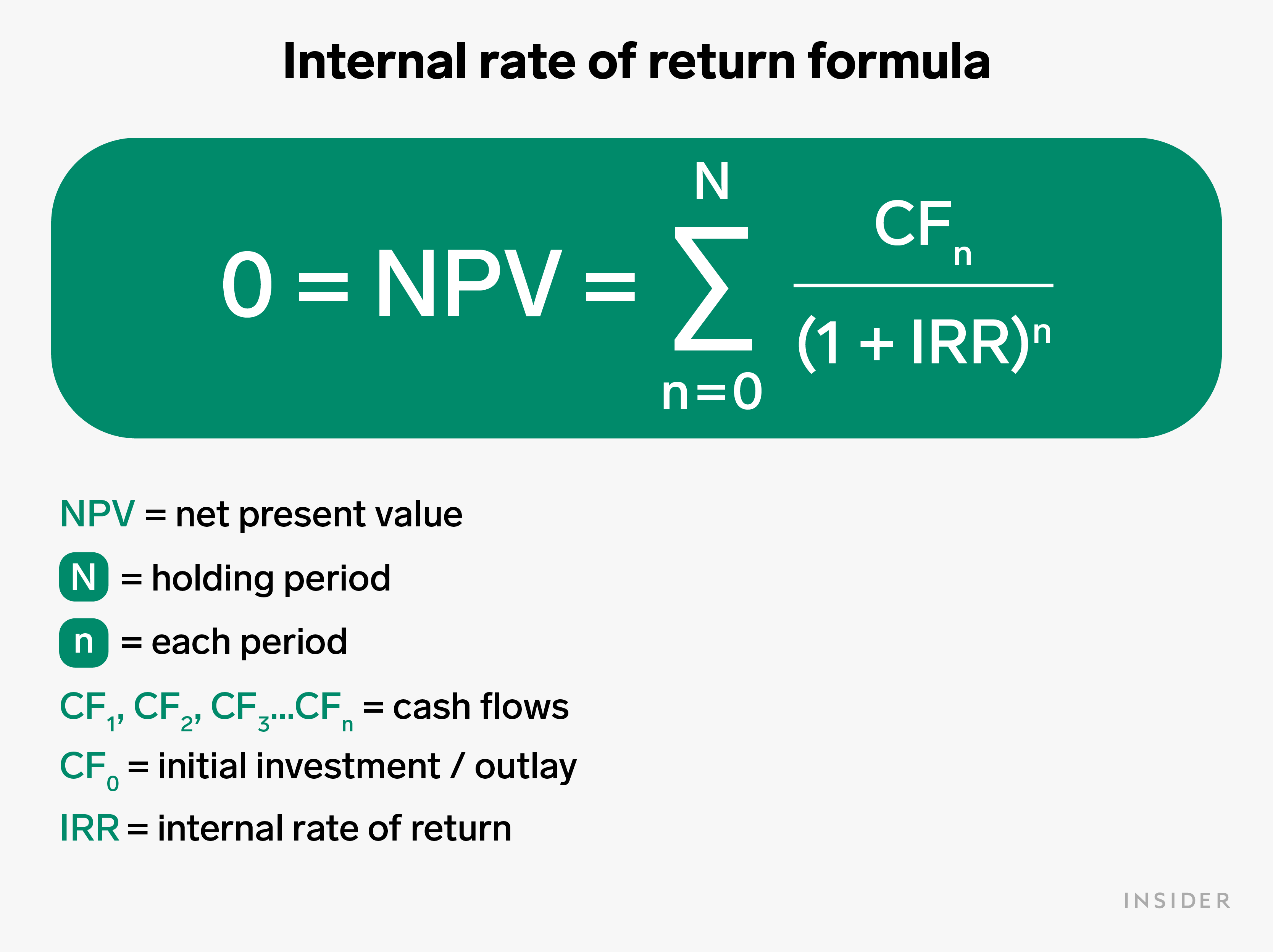
Rachel Mendelson/Insider
- Internal Rate of Return (IRR) is a formula used to evaluate the returns of a potential investment.
- IRR calculates the projected annual growth rate of a specific investment over time.
- IRR is often used to compare similar investments, or in capital planning and budgeting.
- Visit Insider's Investing Reference library for more stories.
Internal rate of return (IRR) is one of several popular formulas used to evaluate prospective investments. It allows you to calculate an investment's potential gains over a certain period of time and determine if it's a worthwhile use of your or your company's funds.
As Daniel Garza, a CFA with Intercontinental Wealth Advisors, explains: "IRR is often used to determine the feasibility of investment projects."
Are you looking to assess a new investment's potential? Here's how calculating its IRR can help.
Understanding how IRR works
IRR is used to calculate the potential annual returns of an investment over time, while taking into account cash flow – the money coming in and out. It's often used to determine where a company's funds are best directed.
For example, you might use it to evaluate whether Investment A or Investment B is the better use of your capital. IRR could also help determine if establishing a new operation or expanding your existing one is the more profitable option.
IRR is most often used in conjunction with hurdle rate - or the minimum amount of returns you need to bring in. Many companies use their weighted average cost of capital (WACC) as their base hurdle rate.
"Once the IRR is obtained, it's compared to the hurdle rate in order to determine if the project is viable," Garza says. "If the IRR is higher than the hurdle rate, then the project adds value."
IRR formula and calculation
The IRR formula is complex, so it's rarely calculated manually. In most cases, investors use an IRR calculator or an Excel spreadsheet, which has a built-in function to determine a project's IRR.
Nevertheless, the exact formula looks like this:

When calculating IRR, you're solving for an NPV of zero. You'll then need the number of years you plan to hold the investment (N), as well as your expected cash inflows and outflows for those periods (CF1, CF2, etc.). From there, you can determine a project's internal rate of return.
Here's an example: Say you're on the fence about purchasing a $100,000 piece of equipment. You project it will bring in $40,000 in annual profits each year, until year six, when it's likely to be out of date or no longer functioning. At that point, you'll sell the equipment for $10,000.
|
Year |
Cash flow |
|
0 |
-$100,000 |
|
1 |
$40,000 |
|
2 |
$40,000 |
|
3 |
$40,000 |
|
4 |
$40,000 |
|
5 |
$40,000 |
|
6 |
$10,000 |
The IRR, in this case, would be 29.7%. If that IRR is higher than your hurdle rate - or the IRR of another similar investment you're considering - it's probably a smart use of your funds.
ROI vs IRR
IRR and simple ROI, or return on investment, are both ways to evaluate the earnings of a specific investment. The main difference is that IRR calculates the potential returns that can be expected over a certain time period, while simple ROI gives you the actual return on the investment, without factoring in timing.
"The biggest problem with ROI is that it doesn't take into account the passage of time, essentially ignoring the time value of money," says Robert R. Johnson, professor of finance at Creighton University.
IRR also requires more detailed data than ROI does. ROI is more "simplistic," as Johnson puts it, requiring just two numbers: Your investment's current value and the initial cost of that investment. For IRR, you'll need an accurate picture of your total costs, cash flow, and holding period.
| Internal rate of return | Return on investment |
|
|
The financial takeaway
IRR can help you evaluate the potential of a new investment or endeavor, as well as compare it with other options you might be considering. Just make sure you incorporate other analyses and consider using a calculator or Excel's IRR function to ease the process. If you need help determining whether a new investment is a smart move or not, consider contacting a financial analyst or advisor. They can help you run the numbers and make the best choice.
